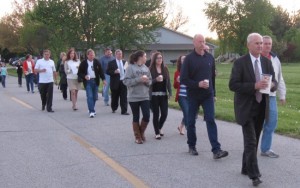
Greater Madison County Federation of Labor remembers county’s fallen workers
By CARL GREEN
Illinois Correspondent
Alton – Workplace safety gains since Illinois adopted workers compensation a century ago and OSHA was founded 44 years ago are continually under attack and must be protected, said speakers at the Madison County Workers Memorial Day Observance.
The annual event, sponsored by the Greater Madison County Federation of Labor, was held April 28 at Gordon F. Moore Community Park.
Following a series of speeches in the Munsterman Pavilion, a crowd of about 100 marched across the park to the Workers Memorial Statue, where a bell sounded as the names of the county’s fallen workers were read.
MINE DISASTER
Madison County Circuit Judge Dennis Ruth set the theme by recounting the development of workers compensation in Illinois, spurred on by the disastrous Cherry Mine fire in which 259 men and boys were killed in 1905 because of unsafe work conditions. There was little compensation for their survivors, but by 1911, the legislature was ready to pass its first workers compensation act, limited only to miners and workers in construction and other hazardous jobs.
Strict limits on how much workers could receive limited the effectiveness of the program. For example, Chicago bricklayers making $44 a week were limited to $12 a week in compensation. By 1970, the maximum was still below the poverty line.
A national commission in 1972 recommended improvements in compensation nationwide, and Illinois reformed its system in 1975, using more of the recommendations than almost any other state, Ruth said, allowing payments equaling two-thirds of wages, letting workers choose their own doctors, and making it illegal to fire workers for filing claims. Further improvements were made in 2005.
“Today, injured Illinois workers or their survivors are protected by a safety net that guarantees they will not fall into poverty, as occurred just a few short generations ago,” Ruth said. “By most measures, Illinois ranks in the top third or higher in workers compensation benefits paid to its employees.
“In large part, this is due to the fact that Illinois consistently ranks near the top of all states in wages and also because of the significantly increased caps,” Ruth added. “A virtually unnoticed result is that Illinois has one of the safest work records for its citizens.”
Workplace fatalities have dropped by 44 percent in Illinois over the past 25 years, he said, while the national average is down 26 percent.
“Illinois’ benefit rates clearly act as an incentive for employers to voluntarily improve their safety efforts,” said Ruth, who served as chairman of the Illinois Workers Compensation Commission before he was elected circuit judge in 2008.
Neighboring Indiana, by comparison, provides benefits near the bottom of the 50 states, but has one of the highest injury rates.
“Those who forget history are doomed to repeat it,” Ruth said. “Today, Illinois’ workers compensation system is under attack for being too generous to injured workers. There are those who say we need to emulate states like Indiana.
“To me, the path is clear. Illinois needs to move forward into the 21st century, not backward into the 19th. Never again should a travesty like the Cherry Mine disaster be allowed to occur in our state.”
WORKING WITH OSHA
OSHA Area Director Aaron Priddy said on average, about 12 people die every workday in workplace accidents in America, and about 3 million are seriously injured each year.
“Twelve lives lost each day are 12 too many, so our work is far from done, and every one of these tragedies should be prevented,” he said.
Priddy said workers must have the right to ask for OSHA inspections without fear of reprisal.
“Workers have to be able to report hazards without fear of reprisal,” Priddy said. “No one benefits if workers are silenced for sounding an alarm when they see a problem.”
Just one day before the ceremony, Priddy said, a painter in Damiansville fell to his death while painting a water tower.
“Our job today is to honor the memory of those workers who died on the job by fighting every day to make sure that employers act responsibly and make their workplaces as safe and healthful as possible.”
EFFECT OF UNIONS
Charles Yancey, business manager and financial secretary for IBEW Local 649 in Alton, said unions have been key in making workplaces safer.
“Through unions, we have a voice in safety on the job,” he said. “We can raise safety concerns and demand that employers empower workers rather than endanger them. Every safety and health protection that we enjoy today is there because men and women formed unions to win these protections. We made the job safer and saved lives.”
Now, Yancey said, unions must fight to keep those protections against withering attacks from extremist politicians and business groups.
He said Illinois is on the front lines of that fight.
“We’ve seen a vicious attack on collective bargaining and unions, with the governor pushing right-to-work zones and attacking workers compensation,” he said. “We must fight back. We can’t allow the governor and his minions to put workers in danger, drive down wages and destroy our communities.
“We must educate, mobilize and organize union members to demand a safe workplace with good pay and fair benefits.”

